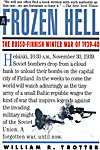 Algonquin Books, 2000 (1991), ISBN 1-56512-249-6, $15.95 trade paperback, 283 pages
Algonquin Books, 2000 (1991), ISBN 1-56512-249-6, $15.95 trade paperback, 283 pages
Bill Trotter drags you into the cold, frozen environs of Finland, and never lets you go until you have a firm grasp of this tune-up war for the Soviets. His attention to detail, down to the company and platoon level, is reminiscent of A Time for Trumpets (by Charles B. MacDonald), as he dissects the Winter War. He brings the Finnish struggle against a larger enemy within arm's reach, breathing life into long-dead heroes and villains.
That the Finns would be beaten, especially in 20-20 hindsight, seemed a surety. The vast resources in men and material of the USSR outnumbered Finland's resources many times over. And yet, thanks to incompetent Soviet generals and even stupider human wave tactics, the Finns slaughtered the invaders. Time and time again, with obsolete weapons and tremendous courage, small groups of Finnish soldiers foiled attacks, inflicted murderous casualties, and maintained the integrity of the Mannerheim line.
"The newly arrived Red infantry performed poorly, however. They panicked under shellfire, and in attack after attack, they were seen milling around under the bombardment like a herd of sheep. Nevertheless, the attacks continued, establishing another trait that would prove characteristic of all the Mannerheim Line battles: the Russians willingness to take needless, hideous losses and still keep coming." (p. 77-78)
Battles on rocky coasts, battles in the deep snows, battles in forests--this book dutifully records a perspective of the enormous disparity in arms, ammunition, and re-enforcements between the two sides.
At the time of the armistice, the Soviets had taken a beating. In the interim, while they shuffled commanders, shot survivors, and replenished men and supplies, the Finns consolidated as much as possible, tried to gain aid from the west, and prepared for the inevitable onslaught.
In the second phase of the war, the Soviets rolled over the Finns, although ultimately forcing a relatively mild set of victory conditions. Finland maintained its independence, although in a year's time would quickly join the Germans for Barbarossa, and ultimately, lose again. And again, Finland, received a mild settlement compared to being occupied.
The Winter War cost the Finns 24,923 killed and 43,557 wounded. It cost the Soviets 230,000-270,000 killed and 200,000-300,000 wounded. Finland gave up roughly 25,000 square miles of land. Finland had started the war with 150,000 men.
Trotter's prose centers the guts, glory, and gore in your mind as you follow the war from the Finnish perspective. A Frozen Hell, just released as a trade paperback from Algonquin (www.algonquin.com), tackles a relatively obscure war with verve, detail, and just plain excellent writing.
Back to List of Book Reviews: World War II
Back to Master List of Book Reviews
Back to Master Magazine List
© Copyright 2000 by Coalition Web, Inc.
This article appears in MagWeb (Magazine Web) on the Internet World Wide Web.
Other military history articles and gaming articles are available at http://www.magweb.com